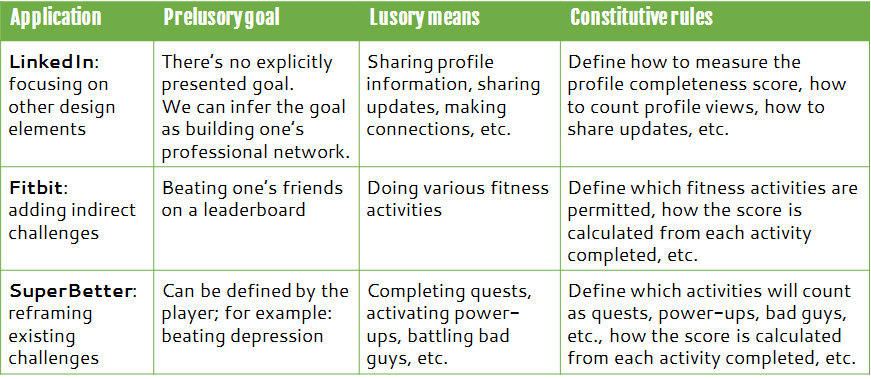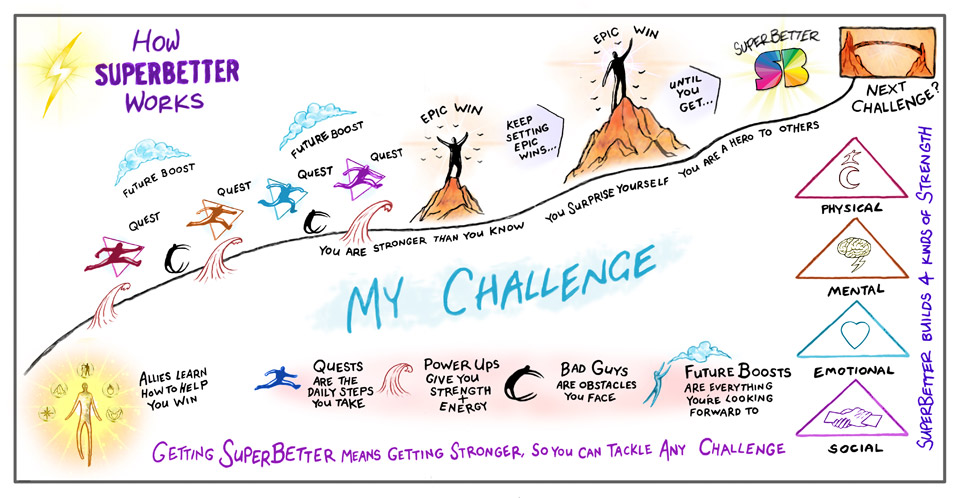There are dozens of different game elements that can be employed for gameful design, from the most well-known points, badges, and leaderboards, to levels and progression, social interaction, competition, rewards, and many others. But there is one important game element that is perhaps underestimated: challenge. Let’s take a look at the important role of challenges for games in general and for gameful design!
What’s in a game?
One of my favourites definitions of game playing comes from Bernard Suits’s book The Grasshopper because it is able to highlight the importance of challenge for turning something into a game. You may already be familiar with his short definition:
“playing a game is a voluntary attempt to overcome unnecessary obstacles”
Bernard Suits. The Grasshopper. 1978. p. 43

Not an easy obstacle to pass through, don’t you think?
This definition describes some of the mandatory conditions that need to exist so that someone is able to play a game: an unnecessary obstacle and the voluntary will to overcome it. What are the implications of adding the adjective “unnecessary” to the sentence? What is the difference between a necessary and an unnecessary obstacle? Let’s have a look at Suits’s expanded definition of game playing to help us answer this question:
“To play a game is to attempt to achieve a specific state of affairs [prelusory goal], using only means permitted by rules [lusory means], where the rules prohibit use of more efficient in favour of less efficient means [constitutive rules], and where the rules are accepted just because they make possible such activity [lusory attitude].”
Bernard Suits. The Grasshopper. 1978. p. 43
Firstly, we can recognize the importance of the prelusory goal: every game has a goal, an objective. Every player must know what they seek in a game. This trait of games is often used to differentiate them from pure play: while pure playing is a free form activity with no explicit goal, playing a game is an activity focused on pursuing a goal. However, there are still many activities that focus on pursuing a goal. It can be said that work is also usually an activity focused on pursuing a goal. So what makes a game different from work or other goal pursuing activities? The other three elements from Suits’s definition, of course!
Let’s look at the next two elements of the definition: lusory means and constitutive rules. Suits argues that to play a game one must create a set of rules that limit the means the player can use to achieve the goal. In addition, one cannot create just any set of goals, but one that is specially crafted to prohibit the use of more efficient in favour of less efficient means to achieving the goal. And this is when the unnecessary obstacles appear. If one only wishes to achieve any goal, the most obvious course of action would be to select the most efficient way of doing so. However, if one wishes to play a game, then one will deliberately create unnecessary obstacles in the form of rules that will make achieving the goal harder and less efficient. Moreover, to be able to play a game one must approach this obstacles with an essential lusory attitude: the will to voluntarily and consciously accept all the limiting rules of the game, the will to find a path to achieve the goals using sub-efficient means, just because this is what allows one to play the game.
Note how the last three elements of Suits’s definition are able to establish a clear difference between playing a game and working. Both activities are geared towards accomplishing a predetermined goal. However, in work one is often required to employ the most efficient means available to achieve the goal whereas in games one decides to voluntarily adhere to rules that prohibit the most efficient means in favour of less efficient means just because of the enjoyment that this affords.
Examples of Games
Suits does a great job of analyzing several examples of games to reinforce this definition. The examples are far too rich to be synthesized on a simple blog post, so I really recommend reading The Grasshopper if you are interested in knowing more. But I can cite some of his simpler examples: golf and running.
Golf

In a golf game, the main goal is to put a ball into a hole in the ground. The most efficient way to do this would probably be to take the ball in your hands, walk to the hole, and just drop the ball in it. But that would not be a game at all, would it? Thus, several rules were created to prohibit this most efficient way of achieving the goal. In fact, the game of golf rules allow only some not straightforward ways of achieving the goal, like hitting the ball with a club. The difficult challenge of mastering these allowed means of achieving the goal is what makes golf a great game.
Running

In a running game, the main goal is to reach a predefined place before your opponents. The most efficient way would probably be to run there in a straight line using the fastest means of locomotion you have. But running games usually limit the means of locomotion that can be used, so that every player must use the same means, be it their own legs or a vehicle. In addition, most running games also limit the path that must be taken to reach the destination, thus players must follow the predefined track instead of running straight to the goal.
Walking home

I also like another of Suits’s examples. Imagine you just visited a friend and now you need to walk back to your place. Imagine there are two possible paths; one is shorter and faster than the other. Your goal is obviously to reach your place. The most reasonable choice would probably be to take the shorter path, however, you can also choose to take the longer path without any trouble. But choosing the longer path does not necessarily turn your activity into a game, as there is no clear loss of efficiency there. Yes, you will take longer to reach your goal, but if you don’t have any particular need to arrive on a certain time, you cannot really argue that one option is less efficient than the other. But if you have any need to arrive before a particular time and taking the longer path makes this goal difficult, then you can say that choosing the longer path is less efficient than choosing the shorter path. If you decide that you must use the longer path to arrive on time just because you want to see if you can overcome this unnecessary challenge, you are creating yourself rules that prohibit the most efficient means of achieving your goal in favour of less efficient means, just because you want to play. Now you’re playing a game! This example is very eloquent because it shows that rules create a gameful experience only when they create a challenge for achieving the goal.
The following table summarizes the defining game elements of the examples above. The lusory attitude is not included because it is always the same: the acceptance of the rules by the players just because they make playing the game possible.

What does this mean for Gameful Design?
Gamification can perhaps be seen as the encounter of games with useful tasks. In gameful design one often wants to create something that affords the enjoyment and motivation of games, yet that allows the execution of useful real-world tasks. We learned from Suits that in order to play a game one needs to be confronted with a challenge and rules that prohibit the most efficient means of overcoming it and one must voluntarily decide to accept these rules. But when a designer is gamifying real world tasks, it is often not desirable to impose rules that will limit the most efficient ways of achieving the goals. For example, a gamified fitness application would probably be designed to help users achieve their fitness goals such as weight loss using the most efficient means possible. Challenging the user to lose 5 kg while eating pizza every day may be a fun challenge, but it’s not what is expected from a gameful application. So how are gameful experiences afforded with gamification without imposing rules that will restrict the most efficient means of achieving the intended real-world goals? Looking at current examples of gamification, we can identify three different approaches: focusing on other design elements instead of challenges, adding challenges that indirectly help achieve the main goal, or reframing existing challenges.
Focusing on other design elements instead of challenges
After arguing about the importance of challenge for the experience of playing a game, it is odd to consider designing a gamified application without it. Nevertheless, many commonly cited gamification examples use this approach. In this case, gamification is understood mainly as a way to improve motivation and engagement with attributes, with less focus on the gameful experience. It is, of course, possible to successfully increase motivation without relying on gameful experiences, as games are not the only motivating kind of experience that exist. For example, LinkedIn is often cited as an example of gamification, yet the introduced design elements are successful at increasing engagement with the service without actually affording a gameful experience. LinkedIn’s design focuses more on elements such as feedback and networking instead of challenges. It is worth noting that challenges and rules may be present in this kind of gameful design, but they will not fulfill a central part of the experience.
LinkedIn profile completeness bar (by Mario Herger)
Adding challenges that indirectly help achieve the main goal
This is probably the most common approach to gameful design. In this case, the gameful experience is not afforded by creating limiting rules to achieve the intended real-world goals. Instead, (artificial) in-game goals are created and the lusory means and limiting constitutive rules are applied to them. Often the means and rules dictate that the only way to achieve the in-game goals is by doing activities that will also help the user achieve their intended real-world goal. This way, the achievement of the in-game goal indirectly facilitates achievement of the real-world goal. For example, a fitness application can build a game around points that the player can earn to upgrade their level or game character, or to compete with other players on a leaderboard. The designer would then create rules that would allow earning points only by completing fitness activities such as walking, running, or cycling while prohibiting other means such as attaching a pedometer to a dog. Thus, playing to achieve the in-game goal (earning points) will indirectly help achieve the real-life goal (losing weight). The four elements that afford a gameful experience are present in this example: prelusory goals (leveling in the game or beating your peers on a leaderboard), lusory means (fitness activities), constitutive rules (that tell what activities are permitted or not, as well as how many points are earned by each activity), and lusory attitude (players voluntarily accept the rules of the application just because they want the experience). This approach is used, for example, in fitness applications such as Fitbit and Nike+, or in productivity applications such as Habitica.
Fitbit’s friendly competition challenge (by Fitbit)
Reframing existing challenges
This approach consists of helping the user identify the inherent challenges of the activity and reframe them by approaching them with a lusory attitude. In this case, the lusory attitude refers to a way of thinking, a way of perceiving the challenge as something that one can voluntarily choose to tackle instead of avoiding it, in order to have a positive experience similar to that experienced in game playing, also called cognitive reappraisal (see Folkman et. al., 1986 and Brooks, 2014 for more information). Usually, there is no need to create artificial lusory means and constitutive rules, as the only means by which it is possible to achieve the goal are probably challenging already. However, the user needs to be able to reframe or reappraise them as well in order to accept them with a lusory attitude, in order to see them as an unnecessary challenge to be voluntarily overcome instead of a required and involuntary challenge. For example, a fitness application would fall under this type of gameful design if the prelusory goal is achieving a better state of health and the gameful elements focus on helping the user achieve this goal through a gameful experience, instead of creating artificial and indirect goals. One example of this approach is the SuperBetter method, by Jane McGonigal. This method is centered around identifying obstacles and adopting a “gameful mindset” to tackle them. To help with cognitive reappraisal, McGonigal suggests reflecting about the worst and best reaction one could have to a challenge, then consider adopting the best option as one’s unnecessary obstacle, challenging oneself to “do something that requires more strength and determination than what someone else might do in your shoes” (SuperBetter, p. 148). Another example is the method of the Lens of Intrinsic Skill Atoms, by Sebastian Deterding, which is also centered around identifying the inherent challenges of the task and restructuring them in order to afford gameful experiences.
SuperBetter method (by SuperBetter)
The following table summarizes the defining gameful elements of the examples above, for contrast with the examples of games from the previous section. Some complex gamified applications can have more than one kind of challenge, but only one of them was chosen as example. Once more, the lusory attitude is not included because it is always the same.

Takeaways
Using Suits’s definition of game playing, I have examined the importance of challenges for affording gameful experiences, be it in games or gamified applications. I have also presented three different approaches that are commonly used in gameful design: focusing on other design elements instead of challenges, adding challenges that indirectly help achieve the main goal, and reframing the existing challenges. When designing gameful applications, It is important to consider which of these approaches will be employed. All of them can be considered valid and successful instances of gamification, yet there are some important differences between them in terms of goals and afforded experiences.
Focusing on other design elements instead of challenges is probably the easiest design approach. However, it is also the approach that is less likely to afford gameful experiences, although it can be successful in increasing motivation and engagement. Adding challenges that indirectly help achieve the main goal is the approach that can more easily afford gameful experiences. However, the addition of artificial goals that support the real-life goal only indirectly can be an issue for some applications or in some cultural environments. It can also make the application seem silly if overused. Therefore, this design approach requires a careful balance of in-game and real-world goals, rules, and mechanics. Reframing the existing challenges is perhaps the approach with the strongest potential for meaningful gamification because it helps users reframe the real-life challenges and goals and work towards better means to overcome them. However, this is also the most difficult design approach where more effort is needed to create design elements that will effectively help users perform the necessary reappraisal or reframing. In addition, the designer has less control over the experience as the application can facilitate cognitive reappraisal, but ultimately this needs to occur inside the user’s mind.
It is also noteworthy that the way a gamified application is presented to users may alter their expectations and, in consequence, their acceptance. For example, the use of the word gamification often creates the expectation of a gameful experience. However, if the approach of focusing on other motivational elements is employed, the gameful experience may not occur, leading to frustration of those users who were expecting it. Another example is that in some cultural environments, such as the gamification of work activities, the risk of turning serious activities into something frivolous may be seen as negative. However, designing gamification through motivational elements that will not introduce limiting rules, or designing it by reframing existing challenges, will probably result in a solid implementation that will avoid introducing unnecessary elements, which could hinder the seriousness of the application.
It is therefore quite important for the gameful designer to know these different design approaches and be able to properly employ, present, or defend them according to the circumstances.
Part 2: I’m in it for the prize! The role of rewards for gameful design
Part 3: Level Up! The role of progression for gameful design







8 Comments
Gustavo Tondello
Another interesting account of the role of challenge in games:
http://www.gamasutra.com/blogs/FabianFischer/20160224/266405/Why_We_Need_Challenge.php